Planting onions in late autumn
- What are the advantages of winter planting onions?
- Onion varieties for autumn planting.
- Where is the best place to plant a winter road?
- Pre-planting preparation of seedlings.
- When to plant onions for the winter.
- Planting winter onions.
- How to protect a garden bed from frost.
- Caring for onions in spring.
- What problems may arise when growing winter onions?
Onions can be grown not only as a summer crop, but also planted before winter.Although this option is less popular, it allows you to get an early onion harvest.
Advantages and disadvantages of winter onions
Advantages of winter planting onions.
- Before winter, the smallest set is planted, the diameter of which is less than 1 cm, it is called wild oatmeal. Such sets are not stored in winter and dry out. When planting in autumn, you get double savings: the seedlings are not only preserved, but also produce a harvest.
- Possibility of obtaining early greenery in spring.
- Receiving turnip harvest 3-4 weeks earlier.
- Small bulbs used for winter planting do not produce arrows, while selections (large sets) always shoot.
- Less damaged by pests than summer.
- During the initial growth period, it does not require watering, since after winter there is still enough moisture in the soil.
- The bulbs are larger and juicier due to the fact that their root system is more powerful.
Autumn planting of onions also has disadvantages:
- Not all of the seedlings will sprout in the spring.
- If there is an error with the planting time, the yield decreases.
- The productivity of the winter road is somewhat lower than that of the summer road.
- Winter onions are stored worse than spring onions.
Overall, the technology has many more advantages than disadvantages. After harvesting the winter onion, it is used first, then the problem with preservation is eliminated.
What onions are planted before winter?
All varieties of yellow and most varieties of red onions can be grown as a winter crop. White onions are less suitable for winter planting. It is better to use varieties zoned for a given region. If the variety is not zoned, there may be large falls, or the onion may not sprout at all.
Varieties that grow very well in winter cultivation are:
- Zodiac
- Viking
- Ellan
- Sturon
- Carmen.
Most of them are salad varieties, unsuitable for winter storage.They are used for canning and processing before the main harvest ripens.
The best predecessors
When growing winter onions, crop rotation must be observed in the same way as for summer plantings. For all types of onions, the best predecessors are green crops and cabbage plants. Good predecessors are:
- tomatoes,
- melons (pumpkin, zucchini, cucumbers) in the southern regions - watermelons and melons;
- green manure (oilseed radish, mustard).
You should not plant onions before winter after any root crops. After bulbous plants, including garlic Turnips and bulbous flowers cannot be planted.
Place for autumn planting of onion sets
To plant onions before winter, choose a dry and sunny place. On waterlogged soil the onions get wet, and in the shade the onions become small. The crop loves to be exposed to the rays of the sun all day long, then the harvest will be higher. When shaded, the leaves grow intensively and the setting of bulbs is delayed. In deep shade, the bulb may not set at all.
The bed should be located where the snow melts first in the spring and the water does not stagnate. When water stagnates in the area, the bed is made with a slope of 1°, this is enough for melt water and precipitation to flow down.
If groundwater is close, drainage is made of sand at least 3 cm thick.
Preparing the soil for sowing
The area for planting onions should have light, well-warmed soil. When groundwater is close, winter onions are planted in high ridges (30-40 cm). Rapidly compacting soils are dug with 1-1.5 shovels; light and sandy soils are dug shallow; when digging deeply, the seedlings may go into deep layers and not sprout in the spring.
The culture requires fertile soils with a neutral or slightly alkaline reaction (pH 6-7.3).Acidic soils are limed. Onions tolerate lime well, so it is added when preparing the soil for planting. To achieve a quick effect, use fluff or ash.
For winter onions, and for other bulbous crops, fresh manure is not applied. It is also advisable not to use semi-rotted manure. This kind of fertilizer causes the onions to wither in the winter, and the one that sprouts in the spring will produce a large amount of powerful, juicy greenery, but will not set a turnip.
The soil is prepared 2 weeks before planting. If you plant the seed immediately after digging, it will go deep and may not sprout in the spring. The earth must settle and settle. When digging, add organic matter (except fresh manure) in a 1 m bucket2, 20 g of superphosphate and 15-20 g of potash fertilizers. The plant tolerates chlorine well, so you can use potassium chloride. An excellent fertilizer is wood ash (0.5 bucket per 1 m2). When using it, potassium fertilizers are not applied, and if liming is necessary, the dose of lime is reduced. No nitrogen fertilizers are used in the fall, since they are washed away by melt water into the lower layers of the soil and are not available to plants in the spring.
On heavy, clayey, quickly compacting soils, add sand 1-2 buckets per m to loosen them2 depending on density. On sandy soils, clay is added to help retain moisture.
Preparation of planting material
To plant winter onions, use sets with a diameter of no more than 1 cm. At home, such seed material is not stored and dries quickly, and when planted it produces good large bulbs. A larger set is not suitable, because when grown as a winter crop in the spring, it goes into the arrow and sets small bulbs.It devotes all its strength to the formation of seeds; inside it has a rod that prevents the turnip from setting.
In order to select planting material, make a hole with a diameter of 1 cm in a cardboard box and sift the onions. The seedlings that passed through the hole can be planted before winter.
2 weeks before planting, the onions are soaked in warm water (temperature 45-50°C) for 3-4 hours. Heat treatment kills pest eggs overwintering in the bottom. Warming up should not be neglected, otherwise you may not get a harvest.
Immediately after warming up, the seeds are treated. Additional treatment of onions against pests is not carried out, since all the eggs have already died. The main pest of the crop, the onion fly, appears in early summer. By this time, the winter road will become stronger, denser, and the pest will not be able to get into the bulb.
For pickling, you can use the preparations Tiram, Fitosporin M, Maxim, soaking the wild oatmeal in them for 30 minutes. Copper preparations are not used for treatment; they help well against downy mildew (downy mildew), but do not protect against root rot.
A good preventative effect is obtained by soaking in a rich pink solution of potassium permanganate. The seed material is kept in the solution for 45-60 minutes, then dried well.
Dates for planting onions in the fall
Winter onions are usually planted at the same time as winter garlic; in the middle zone this is mid-October. But, if you plant garlic in frozen ground, it will not freeze and will still sprout in the spring. But the onion definitely needs to take root; if it doesn’t have time to take root, it will freeze in winter. It takes 14-18 days for the wild oat to take root. In this case, they focus on the weather, planting onions 2-3 weeks before frost.Onions in the ground can tolerate frosts down to -5-6°C, but if the wild oatmeal is poorly rooted, it freezes. In spring, such plants have weak, pale leaves; if severely damaged, they quickly die.
It is important to ensure that the onions do not sprout, otherwise, caught in the frost, they will die. During a long, warm autumn, onions are planted when the temperature drops below 6°C and does not rise above 5-7 days. In the pre-winter period, the soil has not yet frozen, and, at the same time, the seedlings will have time to take root, but will not germinate.
Planting winter onions
The planting scheme for wild oatmeal depends on the purpose of the onion. When growing for turnips, the distance between the bulbs is 10 cm, between rows - 20-25 cm. When growing for turnips, compacted planting is used: the distance between sets is 2-3 cm, the row spacing is 8-10 cm.
Before planting, make rows 5-6 cm deep, at the bottom of which a layer of sand 1-2 cm thick is poured. This is micro-drainage. There should not be a lot of moisture around the bulb in late autumn and early spring; sand is what protects the set from getting wet.
Plant the wild oatmeal to a depth of 3-4 cm and sprinkle it with sand, and fill the furrows with earth on top. Winter onions should not be planted too deep or too shallow. If planted deep in the spring, it will not be able to germinate; if planted shallow, when the soil settles, the onion will end up on the surface and freeze in winter.
The soil should be slightly moist. If autumn is damp, then after drawing the rows, the bed is allowed to air for 30-40 minutes, and then drainage is poured. During dry autumn, the rows are watered.
Preparing beds for winter
2 weeks after planting onions, the beds are mulched with fallen leaves, hay, spruce branches, and peat. Previously, there is no need to cover the plantings, otherwise the seedlings will be too warm and, in a dry autumn, they will germinate, but in a damp autumn they will get wet.
If winters in the region are cold but with little snow, then the mulch layer is increased. When covering the bed with light material, so that it is not blown away by the wind, branches are placed on top. You cannot cover a bed covered with fallen leaves with film. It does not allow air to pass through, condensation always forms under it and in winter the seedlings will either freeze or rot.
If the winter in the region is warm, then the bed does not need to be mulched. In such situations, they always rely on the weather in a particular area. For winter onions, the main thing is that the ground does not freeze before rooting.
Spring onion care
As soon as the snow has melted, the mulch is immediately removed, otherwise the seedlings may rot. The winter plant sprouts very early, as does garlic. As soon as the sun warms up, shoots appear. The crop is not afraid of frost down to -4-5°C, but if the nights are cold, the plants are covered with lutarsil or film. In the morning, the covering material is removed.
When plants are damaged by night frost, the tips of the leaves turn white, and the stem and leaves themselves acquire a whitish-yellow hue. In this case, urgently feed with potassium or calcium nitrate (fertilizers containing nitrogen), they help the onion to survive a stressful situation and promote the growth of new leaves. Urea cannot be fed at sub-zero night temperatures, since it contains pure nitrogen, and this, without the presence of other elements, reduces the frost resistance of plants.
Onion feeding
In the first half of the growing season, winter onions need nitrogen, so when the threat of frost has passed, they feed with weed infusion, humates, or urea. After the formation of 5-6 leaves, give potassium-phosphorus fertilizer (1 tablespoon of each fertilizer per 10 liters of water), or feed the onions with an infusion of ash. But if the soil is fertile, fertilizing is not carried out.
You cannot feed the winter road with manure. The nitrogen contained in manure is needed by onions only during the period of feather growth; then it will prevent the formation of bulbs. But since manure decomposes slowly, the maximum amount of nitrogen enters the soil when the plant sets a bulb. As a result, the onion either continues to grow feathers, or, in rainy weather, rots.
Watering
The winter road is undemanding when it comes to watering. After winter, there is a sufficient amount of moisture in the soil, so no watering is carried out in the first 20-30 days after germination. Then, in hot and dry weather, water the plants 1-2 times a week, depending on the air temperature. All watering (and liquid fertilizing) is carried out strictly at the root. The soil between the rows must be loosened. Onions are very sensitive to a lack of oxygen in the root zone, and if a crust forms on the soil, the bulb suffocates and rots.
If onions are grown for turnips, it is not advisable to cut off the feather. When leaves are removed, plants grow new ones to the detriment of the bulb. If the leaves are removed too much, the turnip turns out to be very small, and may not set at all.
After 35-50 days, depending on the variety, watering is stopped, and in wet weather, the soil is raked away from the turnip so that the bulb can breathe. From this time the bulb begins to ripen and excess moisture harms the plants.
When the feathers are lodged, the onion is ready for harvesting. The winter season ripens, depending on the region, in early to mid-July.
Failures during cultivation
Main reasons.
- The planting depth is incorrectly selected. The onion either does not sprout or freezes.
- Planting sets too late. The oatmeal freezes.
- Waterlogging of the soil in spring. The onions rot.
- Use of unsuitable planting material.The set dried out even before planting and the embryo died.
If all growing rules are followed, failures are minimized.
Problems when growing winter onions
Winter onions have the same problems as summer onions, but they are more acute.
Firstly, the winter road is more demanding on fertilizers than the summer road. Immediately after germination, it experiences an acute lack of nitrogen (like winter garlic). Summer onions need much less nitrogen.
Secondly, onions planted before winter often experience whitening of the tips of the leaves. This also happens to pilots, but less often.
The main causes of whitening of leaf tips.
| № | Signs | Causes | Necessary measures | Notes |
| 1 | The tips turn white and dry out. The plant itself turns greenish-yellow | Onions damaged by frost | Fertilizing with complex fertilizer containing nitrogen | Pure nitrogen (urea, manure) cannot be fed, since the frost resistance of plants is reduced. |
| 2 | The tips turn white, and the leaves themselves acquire a yellowish tint. | Lack of nitrogen in the first half of the growing season | Fertilizing with any nitrogen fertilizer | Fresh and half-rotted manure cannot be used |
| 3 | In the middle and end of the growing season, the tips of the leaves turn white, and they themselves curl slightly | Potassium deficiency | Fertilizing with any potash fertilizer | You can use fertilizers containing chlorine |
| 4 | Only the tips of the leaves have turned white, but the feather itself is green | Copper shortage | Feeding with microfertilizer containing copper | |
| 5 | The tips of the leaves turned white not only on the winter road, but also on the summer onions and garlic | The site has acidic soil | Do deoxidation. For growing crops, an infusion of ash is used. Water each plant (1 glass of infusion per plant) | It is better not to use lime on vegetative crops. |
The technology for growing winter onions has been known for a long time.But, nevertheless, it has not yet received wide distribution.
Continuation of the topic:
- Rules for planting winter garlic
- Growing onions through seedlings
- Planting onions: video
- Growing onions from seeds
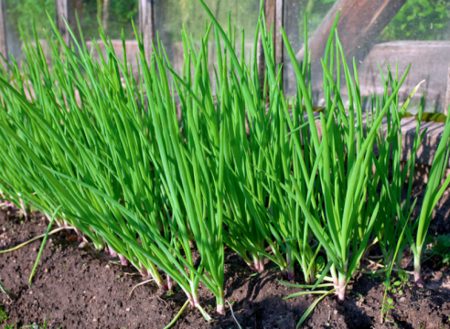
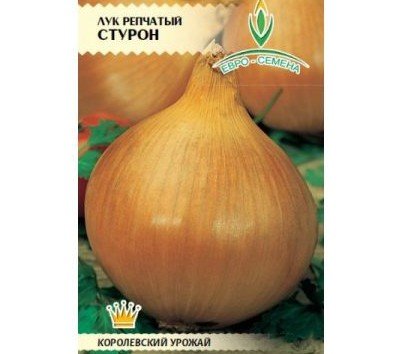
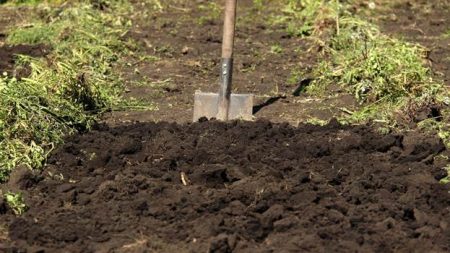

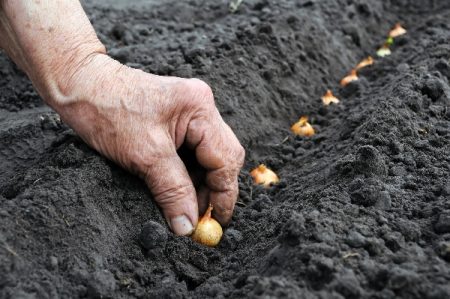
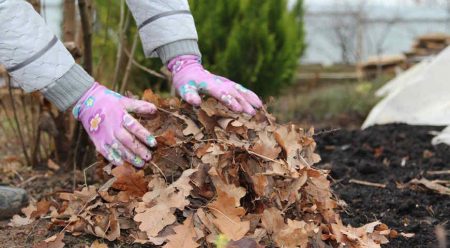
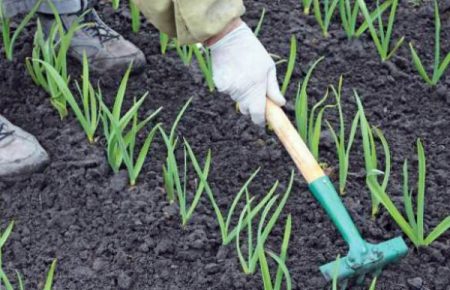

 (18 ratings, average: 4,44 out of 5)
(18 ratings, average: 4,44 out of 5) CUCUMBERS NEVER GET SICK, I'VE BEEN USING ONLY THIS FOR 40 YEARS! I SHARE A SECRET WITH YOU, CUCUMBERS ARE LIKE THE PICTURE!
CUCUMBERS NEVER GET SICK, I'VE BEEN USING ONLY THIS FOR 40 YEARS! I SHARE A SECRET WITH YOU, CUCUMBERS ARE LIKE THE PICTURE! You can dig a bucket of potatoes from each bush. Do you think these are fairy tales? Watch the video
You can dig a bucket of potatoes from each bush. Do you think these are fairy tales? Watch the video
 How our fellow gardeners work in Korea. There is a lot to learn and just fun to watch.
How our fellow gardeners work in Korea. There is a lot to learn and just fun to watch. Eye trainer. The author claims that with daily viewing, vision is restored. They don't charge money for views.
Eye trainer. The author claims that with daily viewing, vision is restored. They don't charge money for views. A 3-ingredient cake recipe in 30 minutes is better than Napoleon. Simple and very tasty.
A 3-ingredient cake recipe in 30 minutes is better than Napoleon. Simple and very tasty. Therapeutic exercises for cervical osteochondrosis. A complete set of exercises.
Therapeutic exercises for cervical osteochondrosis. A complete set of exercises. Which indoor plants match your zodiac sign?
Which indoor plants match your zodiac sign? What about them? Excursion to German dachas.
What about them? Excursion to German dachas.